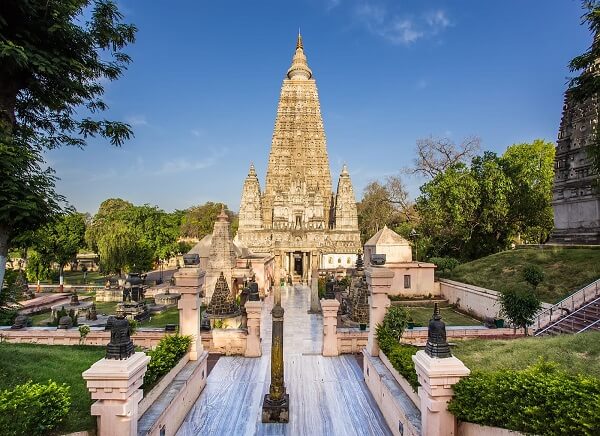The Mahabodhi Temple in Bodhgaya, Bihar, is a UNESCO World Heritage Site known as the "Great Awakening Temple." It is a Buddhist temple that commemorates the enlightenment of the Lord Buddha at the site where he is claimed to have acquired enlightenment. Lord Buddha is considered to be the 9th and most recent incarnation of Lord Vishnu to have walked the world, and hence occupies a special position in Indian religious history. The temple covers a massive 4.8 hectares and stands at a towering 55 meters. To the left of the temple lies the Bodhi Tree, which is thought to be a direct descendent of the tree beneath which Lord Gautam Buddha pondered, acquired enlightenment, and put down his life philosophy. Emperor Ashoka erected the initial temple after converting to Buddhism in order to find calm and seclusion in the midst of wars and conquests.
In roughly 260 BC, the renowned Emperor Ashoka paid a visit to Bodh Gaya. During his visit, he built a tiny temple beside the Bodhi tree, which was the tree underneath which Gautam Buddha sat when he obtained enlightenment. According to an inscription dating from the first to second centuries, Emperor Ashoka's temple was demolished and rebuilt by a new one. Countless monks and followers may be seen prostrating themselves to the tree. It's a cleansing rite, and some monks have been known to perform up to 100,000 prostrations at once. The temple's architecture, as well as the temple's general stillness and calm, will charm you when you visit it.
The Enlightenment Bodhi Tree
The tragedies of the world were too much for young prince Siddharth Gautam to handle. He arrived along the wooded banks of the Phalgu River in Gaya on his mission to abolish all sorrow and agony in the world. Siddharth Gautam acquired enlightenment while sitting in meditation under a pipal tree, and the pipal tree became known as the Bodhi Tree when he was in a profound meditative state for three nights and three days straight. Emperor Ashoka constructed a shrine dedicated to the great Gautam Buddha on this site.
According to legend, the Bodhi Tree arose at the same time that Gautam Buddha was born. According to legend, a lotus will appear on the location where a Buddha is born, and it will blossom in proportion to the number of Buddhas anticipated to arise. According to Buddhist legend, if there is no Bodhi Tree at a certain location at any given time, the land around the tree will be devoid of all flora for a distance of one royal karisa, and no entity, not even an elephant, will be able to travel through this region.
According to the Jatakas, because Buddha attained enlightenment here, this must be the earth's navel; no other spot on the world can hold the weight of Buddha's enlightenment. It's also thought that if the world is destroyed, the Bodhimanda will be the last place to vanish and the first place to reemerge when the world comes back to life.
Mahabodhi Temple Architecture
A black stone Buddha statue with gold paint is put in the innermost shrine of the ancient temple. It was constructed by Bengal's Pala monarchs. The Buddha is seen in the Bhumisparsa Mudra aasana, often known as the 'Earth contacting stance.' The Mahabodhi temple is enclosed on all four sides by two different styles of fences that are roughly two meters high. The antique fences are built of sandstone and date from 150 BC. They feature images of Goddess Laxmi being washed by elephants and Lord Surya riding a chariot driven by four horses.
The more recent ones are built of unpolished granite and are thought to date from the Gupta dynasty. Stupas, reliquary shrines, 'garudas,' or eagles, and lotuses are all carved into them. As a gift from the King of Thailand and Lord Gautam Buddha worshippers, the topmost half of the temple was coated in gold in 2013.
Mahabodhi Temple History
The original construction was mostly constructed of brick and stucco, which is a less lasting foundation than stone. Despite this, the original building has amazingly lasted many years, despite the fact that its lifeblood has been severed. In reality, it is one of the oldest and most majestic constructions from the Gupta period built completely of brick.
Given the centuries since it was built, it is sure to be influenced by the new surroundings as well as natural wear and tear. Under the supervision of renowned British archaeologist Sir A. Cunningham, J. D. M Beglar, and renowned Indian archaeologist Dr Rajendra Lal Mitra, the temple underwent a highly careful and complete scientific refurbishment in 1883. Following that, during the 2500th Buddha Jayanti festivities, the Indian government made additional repairs to the historic temple and enlarged its grounds. As a result, the temple has undergone several restorations, reconstructions, and repairs in order to maintain its unrivaled beauty.
Tips For Visiting Mahabodhi Temple
1. Don't miss the sight of a large group of monks and worshippers gathered around the bodhi tree to worship.
2. Cellphones are not permitted within the temple.
How To Reach Mahabodhi Temple
Gaya Railway Station is the closest railway station to the Mahabodhi temple, at a distance of 16 kilometers. It will cost you roughly INR 80 to INR 120 to take an auto from here to the temple. Because auto rickshaws are rarely in short supply, haggling is not only feasible but also recommended.
It is also a quick and cost-effective alternative to take a bus to the Gaya Bus Stand, which is only 12.4 kilometres away. You may even hail cabs and cars from everywhere in the city, so you won't have any trouble finding this very famous destination.








 +91-7303039611
+91-7303039611